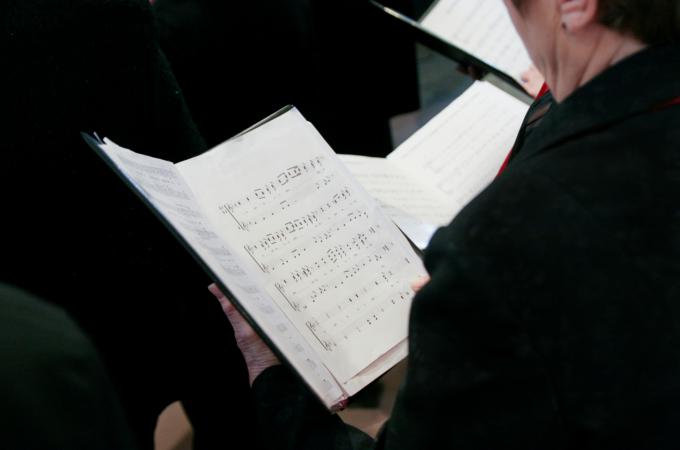Worship in ecumenical contexts
Pastoral leaders are discovering that worship is more central to the work for Christian unity than was earlier thought. So it's no surprise, then, that the topic at this year's annual gathering of the North American Academy of Ecumenists was "Worship in Ecumenical Contexts: A Once and Future Vision."
One of the presenters at this year's Sept. 22-24 meeting, which took place at the Connors Conference Center of Boston College, was Dr. Karen Westerfield Tucker, a United Methodist elder and professor of worship at Boston University. She spoke about the ecumenical implications of singing together, how lyrical and harmonic sharing can serve as a sign of unity among the singers.
Dr. Tucker noted that Catholic hymnals of the post-Reformation era include many Lutheran hymns. Enlightenment era hymnals show even greater use of Protestant hymns. And after the Second Vatican Council, joint worship has motivated further dialogue for unity. "Thirty percent of hymns in Catholic worship books today come from Protestant sources. Hymnody is accurately seen as an ecumenical heritage," she said.
One striking example of this are Christmas carols.
"Eleven of the most popular Christmas carols come from a range of different denominational writers," reported Tucker. And she related how hymn output on Mary has been increasing among non-Catholic composers in the past 10 years. "Singing hymns together in an ecumenical context may inspire a further growing together."
"Singing should never be considered an add-on to the liturgy," Tucker said. "Singing is the liturgy. Singing is the highest form of human expression. The community which does not sing is not a community. It's remarkable that ecumenists have not paid more attention to the role of singing in Christian relations. It's a sign of the Holy Spirit at work, bringing the church into greater unity."
But she also observed that in our present cultural context, singing together is not in vogue. For example, at ballgames, it's a soloist who sings. Keeping communal singing going is a counter-cultural act on the part of the churches. It's one of the only places that people get an opportunity to sing together. The ecumenical community of Taize in southern France is a major preserver of this tradition. And it's easy for people to sing their chants because they're simple and easy to remember.
Another speaker at the conference was Rev. Dr. Gordon Lathrop, pastor in the Evangelical Lutheran Church in America and liturgy professor at Virginia Theological Seminary. He observed that, given the several full-communion agreements between some denominations like Episcopalians, Lutherans, Methodists, Presbyterians, and Reformed in the past 20 years, many Christians are increasingly worshipping together on Sunday.
Dr. Lathrop cited the positive contribution made by the Roman Catholic Church's 3-year-cycle lectionary that brought about the Revised Lectionary which is now used by many different churches and is in close resemblance to the Roman Catholic lectionary. "Thanks to this, clergy can focus on the task of preaching together. And the readings people hear on Sunday are by and large the same ones," said Lathrop.
He also noted common components in the liturgies celebrated across a range of denominations (Roman Catholics, Episcopalians, Presbyterians, Lutherans, United Church of Christ): "The presider is facing the assembly. There are cantors, lectors, leaders of prayer, eucharistic ministers. We listen to the Word of God. We confess the creed and pray the Gloria in the same words. We make common intercessions. We eat and drink the sacred elements and send communion to the absent. Our hymnals have come to resemble each other.
"More and more we are worshipping in the same manner," said Lathrop. "This has made much easier mutual recognition of ordination and ministries between churches that are now in full communion with one another."
Similarly, immersion is more widely used in baptism, and the fonts are given more central place in church architecture.
Cross-confessional friendships have formed as people from different churches have worked together on liturgical renewal. Neighboring congregations have begun to recognize each other, pray for each other, and reach out in ministry together.
A panel discussion, moderated by former Massachusetts Council of Churches director Diane Kessler, featured several people in the Boston area who work to bring people together in prayer and service: Vito Nicastro, ecumenical officer for the archdiocese; Kelly Steinhaus, founder of UniteBoston; and Rodney Peterson, director of the Lord's Day Alliance.
Gatherings in the past five years have been hosted by different congregations around the city. Last January, during the Week of Prayer for Christian Unity, a new "high" was reached when 800 people from a wide range of denominations gathered at Holy Name Church in West Roxbury to join their hearts and voices together in prayer.
- Kevin and Marilyn Ryan, editors of "Why I'm Still a Catholic," worship at St. Lawrence Church in Brookline, Mass.



















